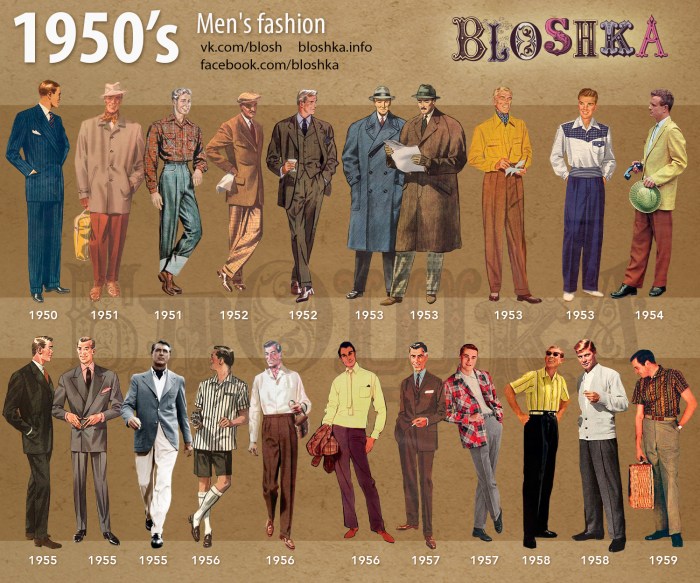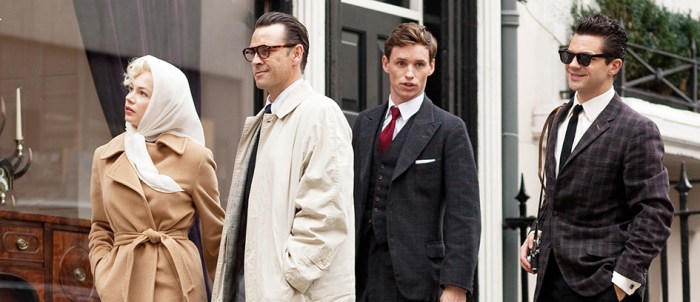Mens Fashion in the 1950s Styles and Icons
The Rise of the “Rebel” Look: Greaser Style
Men’s fashion in the 1950s – The 1950s saw the emergence of distinct youth subcultures, and none was more visually striking than the greaser. This style, born from a confluence of social factors and cinematic influence, represented a rebellion against established norms and a celebration of individuality.
Greaser Fashion Characteristics
Greaser fashion was characterized by its rebellious and sharply defined aesthetic. Key elements included slicked-back hair, often styled with pomade, creating a distinct, shiny look. Leather jackets, typically black or dark brown, were a staple, often paired with tight-fitting jeans or trousers. The overall silhouette was slim and streamlined, emphasizing a lean and athletic physique.
Social and Cultural Context of Greaser Style

Source: behance.net
The post-war economic boom and the burgeoning youth culture provided fertile ground for the greaser aesthetic. It was a visual manifestation of teenage rebellion against parental authority and societal expectations. The greaser look, with its association with motorcycles and rock and roll music, embodied a spirit of youthful defiance and nonconformity.
Comparison with Other 1950s Styles
Greaser style stood in stark contrast to the more conservative and preppy styles prevalent at the time. While Ivy League fashion emphasized neatness and conformity, the greaser look embraced a deliberate roughness and rebelliousness. This difference reflected diverging social values and aspirations among young men in the 1950s.
Common Greaser Fashion Items
| Item | Material | Typical Colors |
|---|---|---|
| Leather Jacket | Leather (cowhide, horsehide) | Black, Brown, Dark Green |
| Jeans | Denim | Indigo, Black |
| T-Shirt | Cotton | White, Black |
| Boots | Leather | Black, Brown |
Ivy League Style: Preppy and Polished
In contrast to the rebellious greaser, Ivy League style represented a different facet of 1950s menswear, one rooted in tradition, academic excellence, and a refined aesthetic.
Origins and Evolution of Ivy League Fashion
Ivy League fashion originated in the prestigious universities of the Northeastern United States. The style evolved from the practical and comfortable clothing worn by students, gradually becoming a distinct and influential look. Its popularity spread beyond the campuses, becoming a symbol of upper-class status and refined taste.
Key Garments of Ivy League Style
The Ivy League look was defined by specific garments, each carefully chosen for its quality, fit, and understated elegance. Button-down Oxford cloth shirts, chinos in neutral colors, neatly pressed trousers, and loafers were essential components. The overall effect was one of effortless sophistication and restrained style.
Influence of Universities and Elite Institutions
The Ivy League’s influence extended beyond its campuses. The style’s association with elite institutions imbued it with an aura of prestige and success. This contributed significantly to its widespread adoption among young men seeking to emulate this image of sophistication and achievement.
A Typical Ivy League Outfit
A typical Ivy League outfit might consist of a navy blue button-down Oxford cloth shirt, worn with khaki chinos, a navy blazer, and brown leather loafers. The fabrics would be high-quality and durable, the fit tailored but not overly tight, conveying a sense of effortless style and understated elegance.
The Influence of Hollywood: Screen Icons and Fashion Trends
Hollywood played a significant role in shaping men’s fashion in the 1950s. Iconic actors became style icons, influencing the clothing choices of men across the country. Their on-screen personas translated into real-world fashion trends, driving demand for specific styles and brands.
Hollywood’s Impact on Menswear
Films often showcased particular styles of clothing, making them aspirational for viewers. The tailored suits of Cary Grant, for instance, became synonymous with sophisticated masculinity. Similarly, the casual, yet stylish attire of James Dean helped popularize a more relaxed approach to menswear.
Hollywood’s Promotion of Brands
Hollywood stars frequently wore specific brands, subtly (or sometimes overtly) promoting them to their audiences. This product placement, often unintentional, had a powerful effect on consumer choices, driving sales and shaping fashion trends.
Influential Male Actors and Their Styles
- Marlon Brando: Rebellious, often wearing leather jackets and jeans.
- James Dean: Casual and effortlessly cool, favoring denim jackets and simple shirts.
- Cary Grant: Sophisticated and impeccably dressed, known for his tailored suits.
- Paul Newman: Ruggedly handsome, often seen in casual wear such as sweaters and chinos.
- Rock Hudson: Exuding a polished and sophisticated style, often in tailored suits and sport coats.
Workwear and Everyday Fashion: Practicality and Style
Workwear in the 1950s, while primarily functional, also influenced everyday fashion. The durability and practicality of work clothes found their way into casual attire, creating a blend of style and practicality.
Men’s fashion in the 1950s often featured clean lines and a sophisticated simplicity, a stark contrast to the bolder styles that followed. The shift towards more flamboyant aesthetics is clearly seen when comparing this era to the decade that followed; for a deeper dive into the evolution of menswear, consider exploring the distinct characteristics of 1980s fashion men , which provides a fascinating counterpoint to the restrained elegance of the fifties.
Returning to the 1950s, we see a preference for tailored suits and conservative colors reflecting a post-war sense of order and refinement.
Types of 1950s Workwear
Workwear varied greatly depending on the profession. Factory workers might wear sturdy overalls and work shirts, while farmers favored durable denim and sturdy boots. Construction workers often wore heavier jackets and reinforced trousers. These garments prioritized functionality and protection over fashion, but their inherent ruggedness and simplicity became appealing elements in casual wear.
Workwear’s Influence on Casual Fashion
The ruggedness and durability of workwear found its way into everyday clothing. Denim jackets, originally designed for practical purposes, became popular casual outerwear. The simple, functional designs of work shirts influenced the style of casual shirts worn by men outside of work.
Comparison of Workwear Across Professions
The differences in workwear reflected the diverse demands of different jobs. A farmer’s clothing needed to withstand the elements and provide freedom of movement, while a factory worker’s attire needed to protect against industrial hazards. These practical considerations led to distinct styles of workwear for each profession.
Practical Considerations in Men’s Clothing Design
Practicality was a key driver in the design and material choices for men’s clothing in the 1950s. Durable fabrics like denim, cotton twill, and leather were favored for their resilience. The designs prioritized functionality, with features such as reinforced seams and pockets designed to withstand wear and tear.
The Evolution of Accessories: Hats, Shoes, and More: Men’s Fashion In The 1950s
Accessories played a significant role in completing a 1950s man’s look, conveying social status, personal style, and belonging to specific subcultures.
Common Men’s Accessories in the 1950s
Common accessories included fedoras, trilby hats, and other headwear styles. Shoes ranged from dress shoes and loafers to work boots and sneakers. Other accessories included belts, pocket squares, and sometimes even jewelry like cufflinks or rings. The choice of accessories often reflected a man’s profession, social standing, and personal taste.
Significance of Accessories in Conveying Style

Source: cloudfront.net
Accessories weren’t merely functional; they were powerful tools for self-expression. A fedora could signal sophistication or rebellion, depending on its style and how it was worn. Similarly, the choice of shoes could indicate a man’s profession or social group. The careful selection of accessories allowed men to refine their personal style and project a specific image.
Accessory Styles Across Subcultures, Men’s fashion in the 1950s
Different subcultures favored different accessories. Greasers often wore leather belts with large buckles, while Ivy Leaguers preferred more understated accessories like leather loafers and simple belts. These differences reflected the distinct styles and values of these groups.
A Typical 1950s Man’s Accessory Kit
A typical 1950s man’s accessory kit might include a fedora hat in felt, dark brown leather dress shoes, a leather belt with a simple buckle, a silk pocket square in a subdued pattern, and possibly a pair of cufflinks. The colors and materials would generally be classic and understated, reflecting a preference for timeless elegance or rugged practicality depending on personal style.
Advertising and Men’s Fashion Magazines: Shaping Perceptions
Magazines and advertisements played a crucial role in shaping perceptions of men’s fashion in the 1950s. They presented idealized images of masculinity and promoted specific styles and brands, influencing consumer behavior and defining the era’s fashion trends.
Portrayal of Men’s Fashion in Advertising
Advertisements often depicted men in idealized settings, wearing the latest fashions. These images promoted a particular vision of masculinity, often emphasizing strength, confidence, and success. The clothing itself was presented as a key component of achieving this ideal.
Themes and Messages in Advertisements
Common themes in advertisements included success, virility, and social status. Clothing was presented as a means of achieving these goals, suggesting that the right clothes could lead to a more fulfilling and successful life. These messages subtly reinforced existing social norms and expectations.
Influence on Consumer Behavior and Perceptions of Masculinity
These advertisements had a significant impact on consumer behavior, shaping men’s fashion choices and influencing perceptions of masculinity. By associating specific clothing styles with desirable qualities, advertisements encouraged men to adopt those styles in an effort to project a certain image.
Examples of Advertisements and Their Impact
Advertisements for brands like Arrow shirts or Hathaway shirts often featured handsome, successful-looking men, subtly suggesting that wearing their clothing would enhance the wearer’s appeal and social standing. These advertisements helped establish these brands as symbols of quality and style, influencing men’s choices for years to come.
Detailed FAQs
What were some common fabrics used in men’s clothing in the 1950s?
Common fabrics included wool (for suits and outerwear), cotton (for shirts and casual wear), denim (for jeans), and leather (for jackets).
How did the rise of television impact men’s fashion?
Television exposed a wider audience to fashion trends, amplifying the influence of Hollywood stars and showcasing different styles to a broader demographic.
Were there any significant differences in men’s fashion across different regions of the US?
Yes, regional variations existed. For example, styles in the East Coast often differed from those in the West Coast, reflecting local cultures and climates.
What role did advertising play in shaping men’s fashion choices?
Advertising heavily promoted specific brands and styles, influencing consumer behavior and associating certain looks with ideals of masculinity and success.













